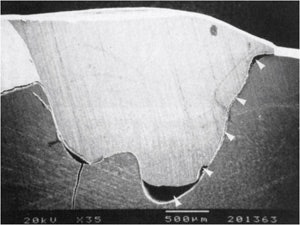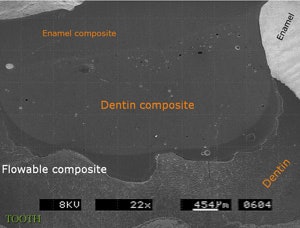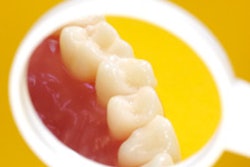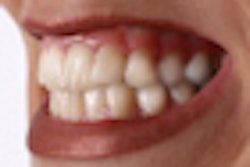
They are in every contemporary dental office. Fifteen years ago they were mysteriously absent from our bonding armamentarium, but today hygienists use them to prevent caries, assistants use them to repair voids and discrepancies on temporary crowns before cementing them, and dentists use them in more than a dozen different techniques. They have become as ubiquitous as insurance claims.
What are they? Flowable composites!
In the mid 1990s, Revolution (E&D Dental, later acquired by Kerr) was first introduced -- arguably as the first flowable composite. And the truth is that pit and fissure sealants, which have been around since the 1970s, are flowable composites. But for this discussion, I'm going to focus on restorative flowables rather than preventive resins.
Originally scoffed at by many opinion leaders as runny composites with questionable uses, flowables soon found their way into many bonding procedures. Flowables can act as an adhesive because they bond well to etched enamel without applying a separate bonding agent.
In fact, filled adhesives became popular not long after flowables were introduced and accepted. Since the introduction of Revolution, almost every restorative dental company has entered the market with its own version of a flowable composite. Their viscosity, consistency, handling characteristics, and direct delivery system make flowable resins a very attractive restorative or adjunctive material.
The Patterson Dental catalog alone now features more than 20 brands and more than 500 individual product choices, ranging from every Vita shade to pink, opaque, pedo white, and bleach white. Add in the companies that sell directly to the dentist and you have well over 700 choices in flowable products. While they are predominantly cured using a visible light source, one example of a dual-cured flowable is Starfill 2B by Danville Materials.
Formulations recently introduced to the market include flowable compomers (polyacid-modified resin composites) commonly used in pediatric and geriatric dental treatment. Sealants are technically flowable composites, but many have very low filler content, such as CliniPro (3M), with only 6% filler. Because of this, many offices have replaced their traditional pit and fissure sealant with a more versatile, higher filled flowable resin.
Lower viscosity
Flowables are simply a low-viscosity composite with less filler than universal composites. Because of this they exhibit lower mechanical properties than universal composites, but they are also two to three times more flexible (less rigid) than universal composites.
Because of this flexibility, flowables have become the material of choice for abfraction, erosion, and class V restorations. Since they have higher resin content than universal or packable materials, they are typically highly polishable (filler size is also a factor). Having more resin means they incur more polymerization shrinkage, but many studies have shown that when used in small, thin amounts, such as a cavity liner, the shrinkage is negligible since the flowable does not bridge any axial walls together. It is surmised that the lower elastic modulus (lower modulus means higher flexibility) of a flowable composite compensates for the higher shrinkage.
What constitutes a flowable? There are no industry specifications so it is up to the manufacturer to classify a resin as such. However, just because a product is labeled a flowable does not mean it actually flows. For instance, an independent research center tested the flow rate of 33 flowables and found many of them did not flow at all (CRA Newsletter, April 2003). This is actually good news. According to the findings, you may wish to use a highly flowable material with better wetting properties, such as Wave (SDI) or PermaFlo (Ultradent Products) for cavity liners, but choose a thicker, less flowable version such as AeliteFlo (Bisco) or Esthet-X (Dentsply Caulk) for class III and V restorations where the material will not run out of the preparation.
Filler loading is also quite variable in this product category, ranging from about 50% up to 68% filler particles by weight. One might think that more filler would yield a less flowable resin, but that is not true. The CRA findings show that the highest filled flowable was in the top three for most flowable, while several products with low filler amounts did not flow at all.
Cavity liner
The most popular use of a flowable is as a thin, highly adaptive cavity liner. In vitro studies have shown that use of a flowable composite reduces restoration microleakage and the occurrence of voids that may cause postoperative sensitivity. Preparations have highly irregular microscopic surfaces, even when cut with flat bottom burs. A flowable liner fills in these "potholes," as well as cavosurface line angles, making it much easier to adapt a thick, paste-consistency universal composite to the newly created, lined surface.
  |
|
Figure 1 (top): Scanning electronic micrograph showing gap formation as a result of poor adaptation of a paste/universal composite to tooth surfaces. Figure 2 (bottom): Note how the flowable resin has transformed the irregular preparation surface to a smooth surface allowing for easy adaptation and gap free placement of the universal composite. |
In 2002, Gordon Christensen, D.D.S., M.S., Ph.D., noted that flowable resins may reduce sensitivity via another mechanism: by acting as a buffer between the tooth and universal composite by obturating any areas of inadequate seal from adhesive placement (CRA Update Meeting, November 2002, Chicago).
Figure 1 shows how a paste composite alone may not fully adapt to the irregular surface of a preparation. Figure 2 shows a magnified view of an irregular preparation surface that has been treated with a flowable liner over the adhesive. If the paste composite does not fully adapt to the surface, it can leave pressurized air pockets that create sensitivity to the patient when biting.
Most dentists have readily accepted flowable composites for a wide variety of applications. Manufacturers list at least 10 uses of flowables, the most common being:
- Cavity liner before placing a paste (universal or packable) composite
- Abfractions, erosions, and class V restorations
- Small class III restorations
- Repair of small defects in restorations
- Pit and fissure sealants
- Preventive resin restorations (fissurotomy in enamel)
- Fabricating temporary veneers
- Bonding porcelain veneers
- Microdentistry: particle abrasion and laser cavity preparation
- Tunnel preparations
- Creating reservoirs on plaster models for custom bleaching trays
- Opaquing metal substrates -- for example, porcelain fused to metal (PFM) repairs
- Periodontal and orthodontic splinting with fibers or wires
- Repair of voids or discrepancies in acrylic temporary crowns before cementation
- Denture repairs: many companies offer different shades of pink
A new application recently came about involving a flowable composite. Kerr introduced Vertise Flow, a self-etch (no rinse) adhesive and flowable restorative in one syringe. While its bond strength may not compare favorably to traditional etch-and-rinse adhesives at this time, this is certainly a step in right direction as biomaterials continue to evolve, thus creating user-friendly, predictable restorative techniques.
Flowable composites, once thought to be a passing fad, have become a versatile workhorse in aesthetic dental procedures.
Phillip L. Brown, D.D.S., graduated from the University of Nebraska Medical Center College of Dentistry. He had a private family practice for 15 years with an emphasis on endodontics and aesthetic dentistry. He then pursued a career in research and development of resin-based polymer restorative materials. He has consulted and worked with several dental companies where he helped to developed many new products. He has been an avid proponent of bonded fiber posts for endodontic rehabilitation and has published dozens of articles related to bonding technology, composites, cements, and posts. Dr. Brown has predominantly lectured overseas with an emphasis on education and hands-on training sessions. He is an active member of the American Association for Dental Research, the International Association for Dental Research, and other societies.
Copyright © 2010 DrBicuspid.com



















